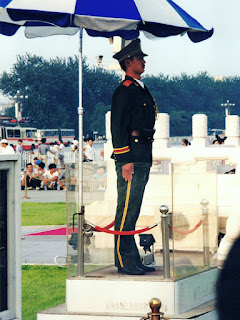Here’s a final post on my very first visit to China in August 1998. You’ll recall my hotel’s tour desk organized a private tour of the Great Wall at Simatai. They also booked me a private day tour covering three of Beijing’s most famous imperial landmarks. This included a morning tour of the majestic Temple of Heaven, a tour of the expansive Forbidden City and an afternoon touring the Summer Palace.
I’ve subsequently visited the temple twice, once with Garry and once with my parents. My blog post about Garry’s visit includes some of its history and its strategic role in imperial Chinese culture. However, for now, I'll give the Imperial Vault of Heaven a quick shout-out. It is surrounded by a smooth circular wall. Known as the Echo Wall, visitors can stand on opposite sides of its internal courtyard and hear each other talk.
The Forbidden City proved every bit as iconic as guidebooks promised. The sheer scale of the complex is hard to comprehend. The compound, surrounded by massive stone walls, is a rectangle 961 metres from north to south and 753 metres from east to west. It contains 980 surviving buildings with 8,886 rooms, a figure which excludes antechambers. As a result, my guided tours took several hours to trace a route north from the Meridian Gate, near Tiananmen Square, to the Gate of Divine Prowess that leads into Jingshan Park.
Meridian Gate is a spectacular entrance. The gate itself is framed by two massive red brick walls on either side extending towards the south. The walls rise more than 12 metres and are capped by a series of ornate Que pavilions (you can see one of these in the image above). The top of the central pavilion sits more than 60 metres above the surrounding courtyard, resulting in a truly dramatic entrance.
The gate has five arches. Three central arches are close together in the main, central section, while two smaller flanking arches lie closer to the protruding wings. The largest central arch was reserved for the emperor’s exclusive use, while all other officials and servants had to use the four side arches.
Once through the gate visitors then proceed through a series of enclosed courtyards, inner gates, and internal moats before finally reaching the emperor’s innermost sanctum. Each of these structures is awe-inspiring. The statistics rattled off by the guide as you walk are simply mind-boggling.
For example, here’s an extract from Wikipedia, describing just the outer walls. Imagine, if you can, similar descriptions progressively bringing to life each courtyard, ceremonial gate, imperial structure, and palace life in general.
The hotel tour desk arranged one final tour during my time in Beijing, a half-day trip to the sprawling Summer Palace complex in the city’s northern suburbs. My private guide took me through the entire palace complex from the main entrance through the primary residence and along a 728-metre-long passway (aptly named the Long Corridor) towards an iconic white marble paddle steamer.
You can read more about the Summer Palace here after taking my parent to see it in 2012. On this second occasion, we didn’t climb Longevity Hill, but did take a boat trip across Kunming Lake. To date, Garry’s never seen the palace.
The following day I caught an early morning flight with British Airways to London. My flight departed from Terminal 1, Beijing Airport’s first modern-era international gateway. This modest building was constructed in 1980, replacing an even smaller, austere Mao-era structure.
It consisted of two stubby wings with distinctive late-70s style interiors, each terminating in a circular atrium with half a dozen departure gates. In the distance, you could see a larger, new terminal under construction. I read recently that Terminal 1 was refurbished and updated shortly after its new neighbour opened the following year. As a result, like much of Beijing's infrastructure at the time, I was lucky to experience its original and archaic formation.
I distinctly recall an old woman sitting behind a simple trestle table next to one departure gate. She was selling handmade souvenirs including miniature terracotta warriors, and other iconic handmade trinkets. It was a genuinely ramshackle affair. Her clay figurines were smeared with residual factory mud and clumps of straw.
The new terminal was opened by the time I returned five years later. However, the airport quickly outgrew this building and a massive third terminal was constructed. I’ve also passed through this third building on multiple occasions. Incredibly, Beijing has now built an entirely new airport on the city’s southern flank to cope with growing demand. As for that first terminal I visited all those years ago, it’s now home to secondary airlines offering domestic flights. Over the years, I’ve seen a similar transformation unfold at airports in Xian and Shanghai.
I distinctly recall an old woman sitting behind a simple trestle table next to one departure gate. She was selling handmade souvenirs including miniature terracotta warriors, and other iconic handmade trinkets. It was a genuinely ramshackle affair. Her clay figurines were smeared with residual factory mud and clumps of straw.
The new terminal was opened by the time I returned five years later. However, the airport quickly outgrew this building and a massive third terminal was constructed. I’ve also passed through this third building on multiple occasions. Incredibly, Beijing has now built an entirely new airport on the city’s southern flank to cope with growing demand. As for that first terminal I visited all those years ago, it’s now home to secondary airlines offering domestic flights. Over the years, I’ve seen a similar transformation unfold at airports in Xian and Shanghai.







































































